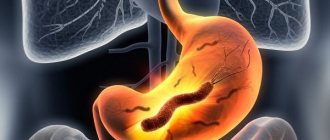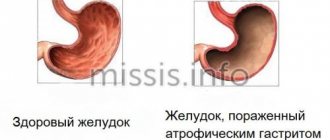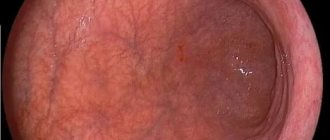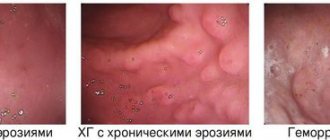general description
Autoimmune chronic gastritis is a pathology that leads to complete atrophy of the gastric mucosa with the development of insufficiency of its secretory function.
This type of gastritis is common in less than one percent of the population, but every sixth chronic gastritis is autoimmune. The progression of the disease, in the long term, leads to anemia, vitamin B12 deficiency, polyhypovitaminosis, and gastric adenocarcinoma. The cause of the disease is the body’s production of antibodies against itself, which damage the mucosal cells responsible for the production of HCl and the so-called internal Castle factor, which is involved in the transformation of vitamin B12. The disease mainly affects the fundus of the stomach. The consequence of this is atrophy of its mucosa, gastric maldigestion, anemia with vitamin B12 deficiency. Atrophy in the initial stages of the disease is focal, and then becomes diffuse. This stage already requires treatment. Autoimmune chronic gastritis often occurs in conjunction with autoimmune diseases of the thyroid gland.
Types of medicines
Treatment of atrophic gastritis involves taking medications. To relieve pain symptoms, discomfort, as well as eliminate the cause of the pathology, special medications are prescribed. There are types of medicines for atrophic gastritis that must be used as part of the therapeutic course:
- antibiotics;
- inhibitors;
- gastroprotectors;
- blockers;
- antispasmodics;
- products containing enzymes;
- antioxidant, tonic drugs;
- vitamin complexes.
Therapy is carried out in accordance with the form and severity of atrophic gastritis. The tablets can be taken after the gastroenterologist has made an accurate diagnosis.
Antibiotics
The use of potent medications is aimed at removing pathogenic substances and infections from the body, which often cause damage to stomach tissue. They should be taken together with medications that restore the natural intestinal microflora after a course of antibiotics.
Potent drugs that are prescribed for the atrophic form of gastritis include:
- Panclave;
- Ospamox;
- Flemoxin.
The substances should be taken for 7 to 10 days, two to three times a day. In adults, the dose of the drug is calculated based on the form of development of the pathology, in children - the weight category. Antibiotics can be presented in the form of tablets, capsules, suspensions.
Inhibitors
Such drugs are prescribed for gastritis with high acidity. Inhibitors help reduce the level of hydrochloric acid and protect the walls of the digestive organ from the occurrence of stomach ulcers. Medicines are aimed at normalizing acidity and the amount of enzymes in the production of gastric juice. Proton pump inhibitors include:
- Omeprazole;
- Ezocar;
- Nolpaza.
These medications are prescribed to be taken once a day before bedtime. The course of taking inhibitors ranges from 14 to 30 days.
Gastroprotectors
Drugs with protective effects ensure the envelopment of damaged cells of the gastric mucosa, as a result of which it is impossible for harmful substances and microorganisms that negatively affect the functioning of the gastrointestinal tract to penetrate into the organ of the digestive system. Gastroprotectors are also suitable for eliminating disturbing symptomatic signs - heartburn, nausea, cramps. Protective equipment includes:
- Hilak Forte;
- De-Nol;
- Venter;
- Vikair.
Blockers
Preparations of this type help prevent the production of substances that negatively affect the epithelium of the inflamed walls of the stomach, cause vomiting, nausea, and also prevent an increase in hydrochloric acid. For atrophic gastritis, the best medicine is Famotidine, which blocks the production of histamine. Taking the drug with meals up to 2 times a day is allowed for 14 to 60 days.
Antispasmodic drugs
With the atrophic form of gastritis, patients complain of frequent pain syndromes. To relieve discomfort in the stomach, you can take antispasmodic drugs, which include:
- Smazmolgon;
- No-Shpa;
- Metacin et al.
For severe stomach pain, you should resort to the use of products consisting of metamizole sodium. Such antispasmodics are contraindicated for pregnant women and children.
Products containing enzymes
Medicines containing pepsin and betaine are prescribed for atrophic gastritis with low acidity. Enzymes enhance the production of gastric juice, the glands of which are responsible for digestion, and restore the level of secretion. To improve the process, which promotes the absorption of the resulting vitamins, minerals, and nutrients, acid-containing drugs are prescribed:
- Pancreatin;
- Enzistal;
- Panzinorm.
The therapeutic course of taking enzymes can last for several years as a preventive measure to maintain the balance of secretion.
Antioxidant, tonic drugs
Medicines are aimed at restoring damaged areas of the epithelium and improving metabolism in the body. Drugs that affect the functioning of the gastrointestinal tract include Solcoseryl, Befungin.
Vitamin complexes
For atrophic gastritis, it is necessary to use drugs containing vitamins of group 12, which in this pathology cease to be absorbed. An effective drug is Cyanocobalamin, which is available in injection forms.
Gastritis of the atrophic form must be treated comprehensively: in addition to drug therapy, it is recommended to monitor nutrition and follow a diet, as well as use folk remedies for indigestion.
The atrophic form of gastritis is a dangerous type of gastrointestinal disease. It leads not only to deterioration of the digestive system, but also to the possible development of cancer. After confirmation of the diagnosis, it is recommended to follow preventive measures throughout life: this is not only proper nutrition, alternative treatment, but also drug therapy.
We recommend: Is it possible to eat prunes for gastritis? – 5 healthy dried fruits
Diagnostics
The diagnosis of chronic gastritis is quite possible to make based on existing clinical symptoms, however, to confirm its autoimmune nature, it is necessary to conduct the following studies:
- CBC: decrease in the number of red blood cells, hemoglobin, platelets, leukocytes, increase in the numbers of the color index.
- Blood biochemistry: hyperbilirubinemia, hyper-γ-globulinemia.
- Immunological examination: decrease in IgA and IgG, increase in the level of B-lymphocytes and T-helper cells by more than 6 times, the appearance of autoantibodies to parietal cells and gastromucoprotein.
- Gastric secretion: decreased acid and pepsin formation, achlorhydria.
- FGDS: the gastric mucosa is atrophic, the antrum is without pathology.
- R-scopy of the stomach: folding of the mucous membrane is not pronounced.
- Histomorphological study: replacement of specialized glands with pseudopyloric and intestinal epithelium.
What can you eat with atrophic gastritis and what can’t you eat?
In case of CAH, the basis of nutrition should be table No. 2 according to Pevzner. Rules for proper nutrition for CAH:
- meals should be regular, at the same time, in small portions, the number of meals increases;
- food should be boiled and warm;
- food should be crushed or finely chopped;
- tobacco and alcohol are excluded.
With atrophic gastritis you can eat:
- dietary meat (rabbit, veal), poultry (turkey, chicken);
- lean fish (pollock, pike);
- dried bread;
- quail eggs;
- fermented milk products (cottage cheese, cheese, fermented baked milk).
- sauerkraut in small quantities;
- porridge cooked in water (rice);
- vegetable broth soups;
- turmeric in very small quantities;
- vegetables (potatoes, zucchini, beets, cabbage, tomatoes);
- allowed ripe fruits and berries (apples, blueberries, watermelon, bananas, avocados, persimmons);
- honey;
- chopped nuts and seeds, sesame;
- diluted juices, tea with lemon, dried fruit compote, jelly, goat milk, mineral water.
What you should not eat to avoid aggravating the symptoms of atrophic gastritis:
- poorly digestible foods (fatty meat and fish, rye bread, smoked meats, mayonnaise, legumes, margarine);
- some types of cereals (millet, pearl barley and barley);
- irritating mucous membranes (turnips, radishes, fresh onions, garlic).
Undiluted juices, strong tea, coffee, kvass, and full-fat milk can provoke an exacerbation of atrophic gastritis.
Atrophic gastritis in the early stages is treated well, the prognosis is favorable. Untreated forms can degenerate into cancer, so it is important to begin treatment when the first symptoms appear.
Treatment of autoimmune chronic gastritis
It is symptomatic in nature, aimed at correcting gastric digestion and preventing complications. Medical nutrition is prescribed. Pain and inflammation in the stomach are relieved, gastric secretion is stimulated, replacement medications and vitamin B12 are prescribed. Correction of metabolic disorders, initiation of reparation processes, eubiotic therapy, and physiotherapy are carried out. During the period of remission - sanatorium-resort treatment. The prognosis for life is favorable.
Essential drugs
There are contraindications. Specialist consultation is required.
- Venter (gastroprotective agent). Dosage regimen: for autoimmune chronic gastritis, adults, 3 tablets orally 2-3 times a day 1 hour before meals or 2 hours after meals. The course of treatment is 30 days.
- Platiphylline (myotropic antispasmodic, m-cholinolytic). Dosage regimen: platiphylline for autoimmune chronic gastritis is taken orally, injected subcutaneously. Spasms of smooth muscles (relief of pain) - subcutaneously 0.2% solution 1-2 ml. Course therapy: orally, before meals, 2–3 times a day, 0.003–0.005 g (children 0.0002–0.003 g) for 15–20 days. Maximum doses: single 0.01 g, daily 0.03 g. During therapy with platyphylline, you should refrain from potentially hazardous activities that require increased attention and speed of psychomotor reactions.
- Abomin (enzyme preparation). Dosage regimen: for autoimmune chronic gastritis, children over 14 years of age and adults are prescribed 1 tablet orally. 3 times/day. during meals for 1-2 months. If the effectiveness is insufficient, the single dose can be increased to 2-3 tablets. for an appointment, and the course of treatment is extended to 3 months.
- Domperidone (Motilium, Motilak, Domperidone) is a stimulant of gastrointestinal motility. Dosage regimen: for autoimmune chronic gastritis, adults are prescribed 20 mg (2 tablets) 3-4 times a day. before meals and before bed.
Features of drug treatment
Before prescribing drugs for the treatment of atrophic gastritis, it is necessary to undergo diagnostic methods in order to avoid misdiagnosis due to similar symptoms with other diseases of the digestive system. There are principles of drug therapy that focus on the timing of treatment. The course of treatment can last up to 2 months without taking into account additional preventive measures.
Drug treatment of atrophic gastritis in adults and children involves the use of medications depending on the characteristics of the disease. The prescribed medications are aimed at relieving pain, improving the digestion process, assimilation of food in the stomach, and normalizing the amount of hydrochloric acid. To maintain and enhance immunity, you should additionally take vitamin complexes containing the necessary acids and microelements.
What to do if you suspect a disease
Blood chemistry
In autoimmune chronic gastritis, hyperbilirubinemia and hyper-γ-globulinemia are observed.
Immunological studies
With autoimmune chronic gastritis, there is a decrease in IgA and IgG, an increase in the level of B-lymphocytes and T-helpers by more than 6 times, and the appearance of autoantibodies to parietal cells and gastromucoprotein.
Fibroesophagogastroduodenoscopy
In autoimmune chronic gastritis, the gastric mucosa is atrophic, the antrum is without pathology.
X-ray
In autoimmune chronic gastritis, the folding of the gastric mucosa is not pronounced.
How dangerous is atrophic gastritis?
The question often arises, why is atrophic gastritis dangerous? This disease is serious and dangerous, since atrophy of the gastric mucosa has a negative effect on the entire body, causing disturbances in the functioning of almost all its systems and organs. The patient suffers from a feeling of permanent fatigue, weakness and general asthenia. In addition, in the absence of proper treatment, atrophic gastritis invariably leads to the development of a number of quite serious complications:
- Stomach ulcer.
- Pancreatitis.
- Development of internal bleeding of the gastrointestinal tract.
- Bulbit.
- Severe forms of anemia.
- Development of cancer.
Atrophic gastritis, especially in moderate form, is quite difficult to diagnose, since its symptoms are similar to various other diseases. If this disease is suspected, the patient is prescribed several types of studies:
- histology;
- FEGDS;
- X-ray;
- blood tests;
- assessment of the functioning of the stomach (gastric juice is examined for the amount and presence of pH content);
- sometimes a biopsy of the affected areas.
- ultrasonography.
These techniques help to identify the presence of atrophic tissue damage and allow not only to make an accurate diagnosis, but also to accurately determine the stage and severity. Accurate and timely diagnosis of atrophic gastritis of any form is the key to successful treatment of this pathology!
How to avoid such problems?
Remember that atrophic gastritis can be cured only if you consult a specialist in time and follow all his recommendations. It is necessary to eat properly, in small portions 5-6 times a day. The stomach should not be overloaded with a huge amount of food.
To prevent gastritis, you should definitely get enough sleep. At night, it is advisable to leave the window open to allow fresh air to enter the room. Any stressful situations should be avoided, and during physical activity you should not allow yourself to become overworked, since this interferes with the production of gastric juice.
If you follow all these tips, after the disease goes into remission, you can live a full life without worrying about your health.
How to cure atrophic gastritis of the stomach: reviews
A large number of people are interested in whether it is possible to get rid of this disease. Unfortunately, there is no single approach to the treatment of this disease, because its forms and manifestations are diverse. It will not be possible to restore the gastric mucosa if the pathology has entered the chronic stage; it is no longer possible to bring glandular cells back to life.
How to cure atrophic gastritis permanently with medications? There are drug therapy regimens for reflux gastritis at various stages. Of course, such treatment will not help to completely get rid of this disease, but it will slow down its further development.
Gastritis
Gastritis
Iron deficiency
8070 March 24
IMPORTANT!
The information in this section cannot be used for self-diagnosis and self-treatment.
In case of pain or other exacerbation of the disease, diagnostic tests should be prescribed only by the attending physician. To make a diagnosis and properly prescribe treatment, you should contact your doctor. Gastritis: causes, symptoms, diagnosis and treatment methods.
Gastritis is inflammatory and/or dystrophic changes in the gastric mucosa of various origins.
The stomach is a hollow muscular organ that is part of the digestive system.
It is located between the esophagus and the duodenum, from which it is separated by circular muscles - sphincters, which ensure isolation of its contents. The stomach consists of several sections: cardiac (inlet), fundus (upper dome), body (central part), antrum and pyloric (outlet).
The gastric wall has four layers: mucous, submucosal, muscular and serous. The stomach performs several functions. It deposits (preserves) food for the time necessary for its primary processing; contraction and relaxation of its muscles (motility) provide mechanical processing of food. Cells of the gastric mucosa produce hydrochloric acid and digestive enzymes for the chemical processing of food, and participate in enhancing hematopoietic function through the production of a specific substance - internal Castle factor. The acid barrier of the stomach prevents the penetration of microorganisms into the underlying sections of the gastrointestinal tract, which manifests the protective function of this organ.
Inflammation of the gastric mucosa - gastritis - is a very common condition that occurs at any age. According to research, gastritis occurs in approximately half of the working population.
Causes of occurrence
Gastritis occurs due to an imbalance between processes that provide protection or cause damage to the gastric mucosa.
Acute
inflammation
is caused by short-term exposure to strong irritating factors.
These can be chemicals (for example, drugs, acids, alkalis), mechanical or thermal irritants (swallowed sharp objects, excessively hot/cold food or liquid), pathogens of foodborne toxic infections (salmonella, staphylococcus, etc.).
Severe stress, massive skin burns, myocardial infarction, etc. can provoke the formation of erosions (superficial defects of the mucous membrane) and stomach ulcers.
Chronic gastritis
is a disease that is characterized by a long process of changes in the structure of the gastric mucosa, up to the replacement of the mucous epithelium with scar tissue, as a result of which the function of the stomach is impaired.
Causes of chronic inflammation:
– the pathogenic bacterium Helicobacter pylori, which infects the middle and lower parts of the stomach, despite high acidity;
According to data from various regions of our country, H. pylori infection is found in 65–92% of adults, and therefore the issues of its diagnosis and treatment are extremely relevant. The high incidence of chronic Helicobacter gastritis causes a high incidence of other diseases associated with this bacterium (peptic ulcer of the stomach and duodenum, stomach cancer). – autoimmune pathologies, in which the immune system perceives the cells of the gastric mucosa as foreign and destroys them, which reduces the production of hydrochloric acid and digestive enzymes; – long-term use of non-steroidal anti-inflammatory drugs leads to a weakening of the synthesis of prostaglandins and a decrease in mucus production, which leads to damage to the gastric mucosa by hydrochloric acid; – reflux (duodeno-gastric) – backflow of duodenal contents into the stomach due to failure of the duodenal sphincter, which leads to inflammation and disruption of the gastric mucosa.
Risk factors for the development of chronic gastritis are bad habits (smoking, drinking alcohol), dietary errors (non-compliance with diet, an abundance of fried, spicy foods), hereditary predisposition, metabolic disorders, hormonal abnormalities, stress, etc. Classification of
the disease
Depending on Depending on the nature of the damage, the following types of acute gastritis are distinguished:
– catarrhal (simple) gastritis
characterized by inflammatory changes in the gastric mucosa, most often occurring with poor nutrition;
– fibrinous gastritis
develops in severe infectious diseases;
– corrosive gastritis
occurs when concentrated alkalis, acids and other toxic substances enter the stomach;
– phlegmonous gastritis
develops when bacteria and protozoa enter directly into the wall of the stomach, with traumatic injuries, as a complication of an ulcer or with stomach cancer.
Types of chronic gastritis:
– superficial non-atrophic gastritis
occurs due to colonization of the gastric mucosa by the bacterium Helicobacter pylori (type B gastritis);
– atrophic gastritis
, which can be
autoimmune
(type A gastritis) and
multifocal
(type A and B gastritis).
Special forms of chronic gastritis: medicinal
(while taking medications),
reactive reflux gastritis
(type C gastritis),
radiation
(occurs as a result of radiation therapy),
eosinophilic
(can develop in people with food and drug allergies).
Based on the source of inflammation, antral gastritis, gastritis of the body of the stomach or all parts of the stomach are distinguished - pangastritis.
Chronic gastritis can occur with a change in the production of hydrochloric acid towards an increase (hypersecretory) or decrease (hyposecretory), but in some cases the level of hydrochloric acid remains normal.
Chronic gastritis can be in remission or exacerbation.
Symptoms
Acute gastritis sharply disrupts the functioning of the stomach and is manifested by a complex of symptoms: pain in the epigastric region (upper central part of the abdomen between the ribs), vomiting (may be mixed with blood), belching, heartburn, and deterioration in general well-being.
With the infectious genesis of acute gastritis, a rise in body temperature and the occurrence of diarrhea are possible - signs of the spread of infection.
In case of poisoning with chemicals, severe pain occurs in the mouth, pharynx, esophagus, stomach, and there may be vomiting of blood and drooling. Due to damage and swelling of the upper respiratory tract, breathing becomes difficult.
Ingestion of foreign bodies may remain asymptomatic, especially if the object passed through the esophagus without damaging it. The only manifestation may be increased salivation. If a foreign body remains in the stomach, there may be direct damage to the gastric wall with the development of bleeding or, over time, a pressure sore of the stomach wall with the formation of a hole, which is a life-threatening condition.
Chronic gastritis develops gradually and is characterized by a slow increase in symptoms of dyspepsia - signs of impaired digestive function.
These include: a feeling of heaviness in the epigastric region during or immediately after eating, belching, heartburn, stool disorders, intolerance to certain foods, medications. There may be pain on an empty stomach, nausea, vomiting (including blood or bile), and changes in appetite. The listed symptoms occur in various combinations in certain forms of chronic gastritis.
It should be remembered that changes in the condition of the gastric mucosa may not be clinically apparent.
Diagnostics
Diagnosis of gastritis is based on collecting anamnesis, identifying the clinical picture, and a thorough examination of the patient.
To clarify the nature of damage to the mucous membrane, study the function of the stomach, and search for the causes of inflammation, the following laboratory and instrumental studies are used:
– reference methods for diagnosing H. Pylori infection, as the most common cause of chronic gastritis, are a breath test with 13C-labeled urea and a test for the presence of H. pylori antigen in stool;











